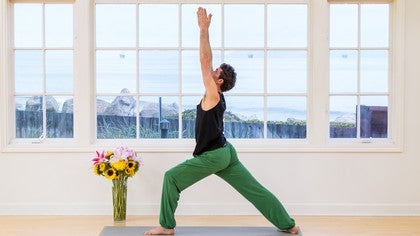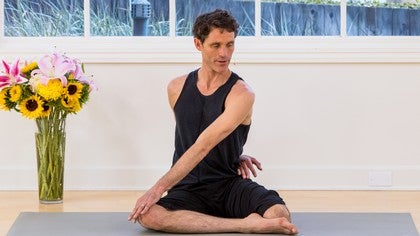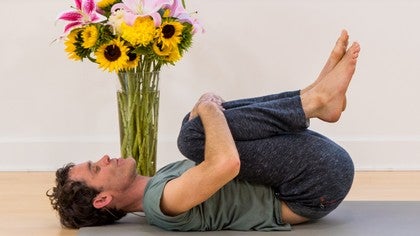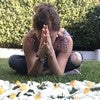Description
About This Video
Transcript
Read Full Transcript
(waves breaking) We're gonna do a practice that is for when you're feeling overhwhelmed. There is a lot of yoga research that's been done on the effect of yoga for the emotions. And one of the truths that's come out of that research is that your breath is one of the most powerful tools you have that you can access at any moment to help balance your emotional state. And so particularly lengthening your exhales has a calming effect on the mind. And so what we're gonna be doing is we'll use this simple cross-legged position called Sukhasana, and then we'll do some variations of a pose that's called Bharadvajasana.
And so what you do to get into Bharadvajasana, is you're going to bend one leg back and you have the heel of that foot near the outside of your hip. You have your knee near your front heel, so you make this kind of triangular shape with your legs. And you can slide so the arch of your foot is cupping the inside of your knee. So it's something like that. And we'll do both sides and some variations.
So to begin with, though, come back to Sukhasana. I like to do this one with the ankles lined up with the knees, and then just rest your hands palm down on your knees. As you come into the shape, lengthen your breath into the Ujjayi pattern. Long exhalation. In this practice, try to keep your exhalation about half again as long as your inhale.
Long exhale. The best way to set up this rhythm is to notice how long your inhale is and more or less just approximately make the exhale 1 1/2 times longer. So for example, if your inhale was four seconds, your exhale would be six seconds. If your inhale was six seconds, your exhale would be nine seconds. Something along those lines.
(deep breathing) And as you exhale with each breath, deepen your concentration on the breath. Take two more breaths that way. As you inhale noticing the sensation of the breath descending into your abdomen, grounding through your hips. With your exhalation relaxing your mind, relaxing your body, relaxing your emotions, making space for having all of those experiences. And now with your next inhalation, you're going to bring your left foot back first.
So you turn that left leg back, heel comes next to the outer hip, left knee tucks into the arch of the right foot, then bring your hands here on your knees. Bring your hands back behind you with your first inhale, and you're gonna do just a gentle back bend. And as you inhale again, feel the inhale coming down. With your exhale, extend your exhale so it's about 1 1/2 times longer than your inhale. (deep breathing) One more breath that way.
(deep breathing) With your next inhalation we're gonna come into the twist. You can do any of these variations in Half Lotus. This first round I'm gonna keep the leg down, but if you choose to, go ahead and go into the Half Lotus and if you have long arms like me, you can actually hold your foot behind your back. If not, just either, even if you're in Half Lotus and you can't reach your foot, or you're in this variation with the foot on the ground, you reach your right hand behind your back, so that it holds your inner leg and then cross your left arm across your body, turn your gaze over your left shoulder. And then for most people, your right hip will be a little bit off the ground, so don't necessarily try to get both sit bones on the ground.
But do try to keep the feeling that your spinal weight is carried through your pelvis evenly. Even though your left sit bone may not be grounded, you can feel that the pelvis is balanced. So deep inhale into your belly. (deep breathing) As you inhale feel the breath down into your low spine. As you exhale, relax your shoulders and let your body ground into the shape even more.
Relax along the column of your spine, making room for the twist. Relax between your shoulder blades. Two more breaths like that. (deep breathing) Long exhales will calm your mind. Now, with the next inhale come back to center, hands on your knees.
Set yourself up, and as you exhale, walk yourself out. Long smooth exhale coming into a forward bend. And if your head comes down the ground, your forehead will rest on the ground. If you're a little higher up, you'll use your arms to support so you stay grounded on your hips, but then completely relax your neck. (deep breathing) Exhaling here, relax from your shoulders.
Feel the weight into your pelvis. In this position, your hips, one hip's in flexion, and the other hip is in extension. And one of the ways this is understood in the yoga tradition is that by having the hips in this way, it will help you to not stay mentally fixated. And sometimes when we're overwhelmed, we sort of hyper-focus on our feelings of overwhelm and get stuck there. So this position in the hips is actually supportive of breaking up mental fixation and stagnation.
One more exhale, long exhale out here. And then inhale, bring yourself back up. And we're just gonna shift over to the other side. You bring the left leg in front. The right leg comes behind you.
Again, the right heel is next to the sit bone. Left foot is at the knee. I'm gonna do this side in Lotus with the arm bound. So I reach behind and as I take ahold, I put my thumb between the big toe and second toe and they bind up that way. I like to put my thumb between my index and middle finger.
With the first back bend, I can go into it with the arms down, and if you're able to do this with the arm bound, you can just do it with one hand. So that's another variation that's a possibility here. You get the arm into just the right spot to support you, and then start to gently arc the spine. If you wanna take the head back, you can. (deep breathing) Take one more breath there.
Long exhales, remember that. 1 1/2 times as long as inhale, exhale. And then when you come out of that, if you're already bound, you can go right into the twist. If you had both hands back, you're gonna take the left hand behind the back, right hand on the knee, an as you exhale, look across to the right shoulder. And settle from the shoulder.
It feels like you relax the weight of the shoulderblades down the back, but as you do so, that'll have the effect to keep your chest open without you having to pump the chest up. And it'll keep you from collapsing your low back. So take two more breaths that way, where you inhale. (deep breathing) Feel the breath down into your low back and your pelvis. And then let out that long exhale.
Really focus your mind during the exhale. (deep breathing) Inhale, come back to center. Then walk yourself out, slowly but surely. Give yourself just the right position. And again, if it's comfortable and it's possible for you, you bring your head down the ground, keep your arms straight with your palms flat on the ground.
Make sure that you feel grounded in your hips and take three breaths here. (deep breathing) One more breath. Then walk yourself back up seated. And this little Vinyasa comes back to where you started. So you come back again with your ankles under your knees.
Bring your hands to your heart. And as you bring your hands to your heart, feel the pressure of your thumbs on your breastbone. That has a grounding and calming influence, too. Take three finishing breaths here. (deep breathing) One more breath.
Nice smooth inhale. Long calming exhale. Namaste.
Prana: Robert Svoboda & Scott Blossom
Comments
You need to be a subscriber to post a comment.
Please Log In or Create an Account to start your free trial.




















